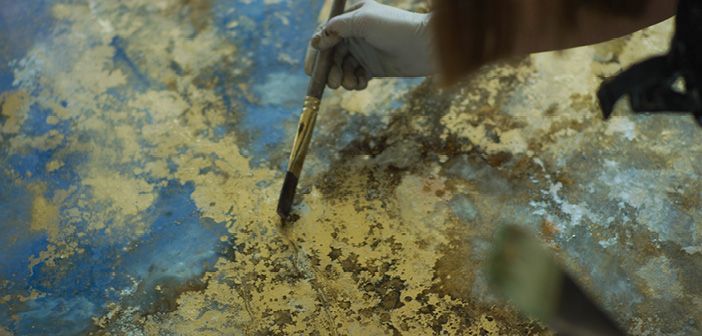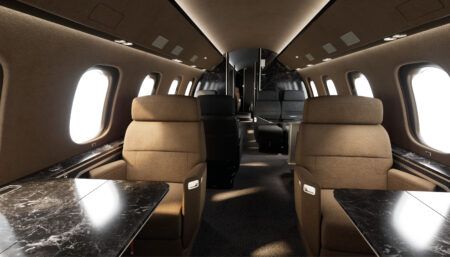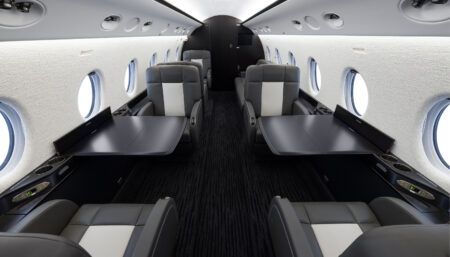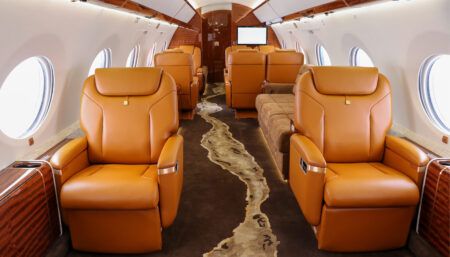Alina Young of Artelier gives an exclusive insight into the process of curating and delivering artworks for private jet interiors
The private jet traveller is accustomed to exquisite interiors – be that in exclusive residences, sophisticated hotels or on board superyachts. As art consultants, Artelier’s cross-sector expertise in these contexts informs a deep understanding of VVIP clients’ tastes, and experience in elevating interiors through art. Private jet cabins have unique technical requirements, and so art consultants must deliver artworks to the standard of the world’s most luxurious interiors, whilst adapting art to the private jet environment.
Why incorporating art is essential to jet interiors
A key trend in private jet interiors is creating a ‘liveable’ onboard atmosphere. Jet interiors now seek to recreate domestic spaces, like a comfortable dining room, office, entertainment features and luxurious bathrooms – all presented with high-end interior design worthy of clients’ refined residences on land.
Artworks are essential for recreating the feel of a home. Inherently a luxury item, artworks add an air of sophistication, as well as the feeling of an authentic and lived-in interior. In the private world of a business jet, artworks are also a way for clients to express their personal tastes and interests, and truly make a private jet feel their own.
Custom-made art also gives the opportunity to enhance a design scheme through complementing its colour palette and interior finishes. A complete bespoke art collection on board can tie together the overall design between spaces, strengthening the impact of ambitious concepts.
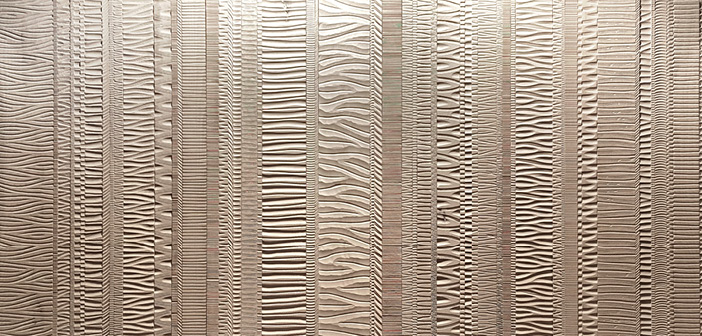
New contexts for art on board
Completely bespoke art commissions are an excellent way to create a one-of-a-kind space, as the artist creates completely unique decoration that is not available off-the-shelf. Art concepts may be introduced by the designer or art consultant.
Due to onboard weight restrictions and the limitations of curved walls, Artelier’s curators have seen an increased interest in mural and feature wall artworks. Although there are feature wall companies who produce a catalogue of designs in aviation-grade materials, working with an artist can result in a custom collectors’ piece. For instance, one of Artelier’s upcoming projects is developing a gold-leaf artwork that stretches across the ceiling of the entire cabin, flowing from room to room. Featuring delicate clouds and blooming foliage, the artwork develops from more golden hues in the lounge and dining area, into a silvery finish created from moon gold leaf for the bedroom.
Equally, however, ideas for bespoke commissions can also be led by clients themselves, who may request pieces in a particularly loved style. On a recently completed project, one of Artelier’s private clients wanted to recreate Monet’s Impressionist water lilies as murals across a BBJ 737’s cabin walls. The 20 water lily murals immersed viewers in the paintings’ serenity, creating a calming, pastel-coloured interior that brought nature to the skies. For the painting surface, specialist curved wall panels were created in consultation with the completion centre, which were then wrapped in aviation-grade canvases. To recreate the thick impasto painting technique typical of Impressionism, Artelier and the artist tested air-safe paints that could produce an effect that felt authentic to the style.
With limited space on board, spotting more unusual contexts for artworks offers new opportunities. There has been a growing popularity in TV roller art, which discretely conceals blank screens and provides an attractive centrepiece when the screen is not in use.
Using collectable contemporary art instead of prints offers something new to the aviation industry. With specialist knowledge of artistic techniques, Artelier develops technical solutions that allow an artwork to be repeatedly rolled without damage. The roller mechanisms are also designed to be removable, so that if the owner decides to move their commissioned artwork to another context, it can easily be re-stretched.
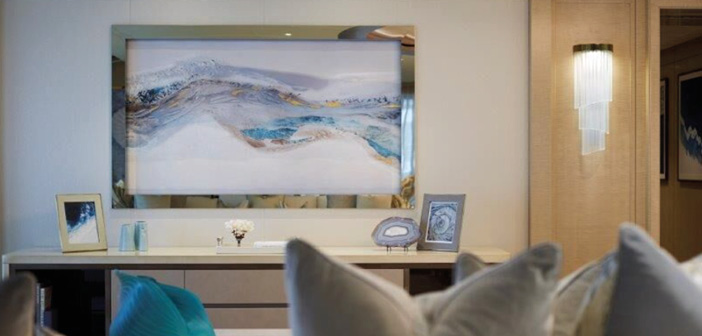
The unique challenges of aircraft interiors
With restrictions on weight, flammability, toxicity and fixings, the environment of an aircraft cabin presents unique requirements for artworks. In addition, there may be special considerations for particular areas, such as ensuring that artworks in wellness areas can withstand heat, moisture and steam.
Having a wide knowledge of contemporary artistic practices enables curators to address these needs. Choosing suitable materials is a priority; for instance, modern, lightweight mediums like aluminium with aircraft-grade lacquer are better options than impractical, heavy mediums. It is also essential to consider maintenance. Materials like ceramics and glass are excellent options for bathroom areas, as they are easily cleaned and water resistant. For previous projects, Artelier has supported artists in adapting their techniques, such as developing lighter porcelain pieces or working with shatter-resistant glass suitable for aircraft cabins.
Refined presentation is crucial for any artwork – even a stunning piece can seem lacklustre in the wrong frame. This can be a particular pitfall for aircraft interiors, as there are far fewer options available for frames, mounts and plinths, which must meet safety regulations and consider space limitations.
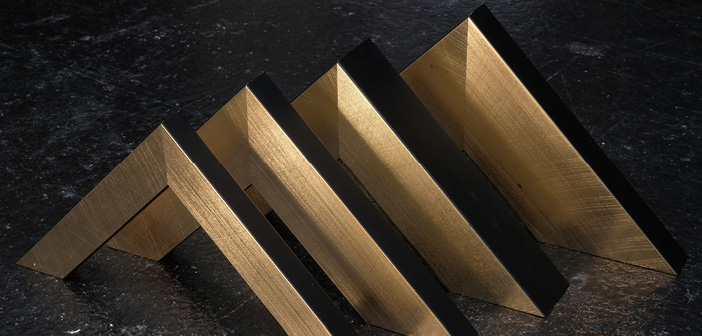
For land-based projects, Artelier offers a framing consultancy with exclusively designed frames, and so sought to bring this level of luxury and customisation to the aviation world. Collaborating with framing specialists, it utilised advances in 3D printing technology to recreate any conventional frame profile into aviation-grade materials. Hand-finished with air-grade lacquer and coatings, the frames resemble wood, antiqued gold, pewter or bronze, and are adapted to complement the design scheme. Aviation-approved Lexan is used in the frame instead of glass, since it is highly transparent, shatter-resistant and fire-proof.
Art is then hung with made-to-measure fixings to lock artworks onto the wall discretely. Altogether, the aim is to achieve a feeling that neither the artwork nor the presentation have to be compromised for life in the air, and that highly technical solutions feel natural and effortless.
Key trends for the future
Globally, industries and consumers are placing increasing importance on sustainable practices. Aviation faces a particular challenge to lower environmental impact, and so a holistic approach is essential – every element of aircraft design must be considered, to maximise the sustainability of air travel.
Art offers an opportunity to decorate sustainably, and so low-impact pieces are becoming an ever more popular request from clients. This approach favours more organic and renewable materials and moves away from the use of precious metals or plastic. Artistic mediums such as wood, paper, ceramics and textiles are all sustainable and even biodegradable, but there are also opportunities for lessening the environmental impact of other mediums – such as using natural earth pigment paint, or recycled metal.
These mediums are in line with the contemporary trend within interior design that favours a minimal and simplified aesthetic, and highlights the inherent beauty of natural materials. Sustainable artworks will inevitably continue to grow in popularity, becoming a prominent feature in aircraft art and design throughout 2022.


